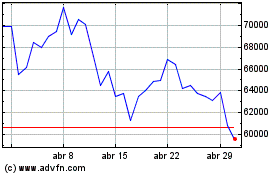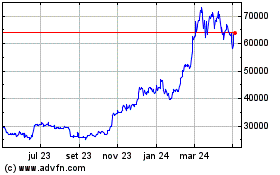Solana DeFi Goes Stratospheric as Hubble Protocol Announces $3.6M Raise
21 Dezembro 2021 - 11:49PM
NEWSBTC
The decentralized finance (DeFi) project Hubble Protocol has
recently closed a seed funding round that raised $3.6 million. This
early support for Hubble comes from several major and influential
names in the crypto industry who are key players working to expand
DeFi on Solana, which is currently the world’s fastest blockchain.
Participants in Hubble’s early private round include Jump Capital,
Delphi Digital, CMS, Mechanism Capital, Spartan, DeFi Alliance,
Three Arrows / DeFiance Capital, Digital Strategies, and Decentral
Park Capital. Each of these backers has thrown their weight behind
Hubble as it enters the quickly growing DeFi market boasting a
total value locked (TVL) of over $200 billion spread across
multiple blockchains. This show of support for a DeFi hub on Solana
will hopefully help revive DeFi composability and onboard the next
million users to DeFi services offered with low-cost transactions
on a single Layer 1 blockchain. Solana’s Quest for One Billion
Future Users Heats Up Blockchain technology has been hailed as the
next big disruptor for countless industries including streaming and
social media, supply chains, and financial services. Additionally,
the future of the web, known as Web3, will rely on distributed
ledger technologies (DLT) like blockchains in order to make the
next step-change in connectivity possible. However, early attempts
at building a blockchain that can handle the scalability necessary
for onboarding the next generation of the web have run into
multiple issues. Time and again, Ethereum Virtual Machine (EVM)
blockchains have proven to face congestion periods where
transaction speeds slow down while the cost of transactions rises
dramatically. As a result, the advancement of innovations made
possible by blockchain tech has stalled–that is, until Solana began
firing up in earnest earlier this year. Many have taken notice of
Solana’s scalability, speed, and low costs for transactions. Last
month, during Solana’s Breakpoint conference, Reddit Co-Founder
Alexis Ohanian pledged $100 million to build social media platforms
on Solana’s network. More recently, Michael Jordan has turned to
Solana as the home for his own NFT enterprise. In November, Solana
Co-Founder Raj Gokal stated Solana’s ambition was “to see 1 billion
people using the network,” and realizing this goal means a
proliferation of user-friendly projects that solve major pain
points for the world’s population. Developed with mass adoption and
growth in mind, Hubble hopes to be a large part of onboarding the
next generation of users that add up to Gokal’s billion. Hubble
Build on Solana Tech to Empower DeFi Users According to Delphi
Digital Co-Founder Yan Lieberman, “We are very excited to be
investors in Hubble. Delphi continues to be a supporter of the DeFi
ecosystem and its potential for impact across every vertical within
finance.” Lieberman also noted, “One of the many exciting
ecosystems for DeFi innovation is Solana, and accordingly the
developer activity there has boomed over the last year. The team
behind Hubble is world-class and we are thrilled to work alongside
them to build DeFi primitives, from borrowing to structured
products and beyond.” Hubble’s first phase of development seeks to
launch a Solana-native stablecoin, USDH, and DeFi 2.0 borrowing
services that “supercharge liquidity” for its users. After
developing this phase of Hubble’s launch, the protocol has declared
two more phases of development that will introduce structured
products and undercollateralized lending, the last of which has
been considered a “holy grail” in crypto for quite some time. The
combination of Hubble’s financial services and the cost and
scalability of Solana could mean millions of people will gain
access to finance through Solana-powered DeFi in the near future.
USDH Fills a Stablecoin Gap in the Solana Ecosystem Stablecoins and
the ability to increase one’s liquidity by borrowing against assets
are two key elements of DeFi. The crypto market would fall apart if
everyone sold their bitcoins, but what’s the point of holding a
valuable asset if holders cannot benefit from that asset’s value?
In order to reap the rewards of holding valuable tokens, many users
have turned to DeFi borrowing platforms in lieu of selling their
crypto. This means that the practice of taking an
overcollateralized stablecoin loan has become a standard procedure
as one of the first steps for participating in DeFi. Due to
Solana’s low-cost transactions, Hubble’s development on the network
ensures users are getting an improved user experience through
maximum capital efficiency. Another effect of building on Solana is
that Hubble will be able to launch a stablecoin that should
theoretically remain very close to the value of USD through
constant arbitrage. Decentral Park Capital’s recently published
investment thesis asserted that, “We believe Hubble is more than
just a DeFi Hub. Hubble is building a primary stablecoin for the
Solana ecosystem.” The firm went on to say, “We believe USDH can
also form the build[ing] block for other DeFi protocols that
encompass stable assets at the core of their design.” Hubble
Protocol Attempts to Democratize DeFi for the World Much of
Hubble’s borrowing platform is geared toward increasing revenue for
its users. Users who stake HBB on Hubble will earn most of the
protocol’s fees, and these will mostly be paid in USDH, which is
collected at a 0.5% rate for minting the stablecoin. One of the
novel approaches to sharing revenue with users is the way Hubble
handles liquidations for bad loans. Whenever a loan reaches or
falls below a 110% collateral ratio, any user can trigger
liquidations and earn a small portion of the liquidated account’s
leftover assets. The rest of the assets are split between users who
deposit USDH into Hubble’s stability pool. This “liquidation
democratization” was first pioneered by Liquity, a borrowing
protocol based on Ethereum, which has become a difficult chain to
use for many due to high transaction costs, so a small portion of
the DeFi community that can afford Ethereum’s gas fees have been
able to benefit from this innovation. Translating the idea for a
stability pool onto a network that the general public can afford to
use will see more users receiving a fair share of liquidated assets
on Hubble. As more users begin their DeFi journey on Hubble, and as
Hubble continues developing into a stable protocol, it will one day
fully decentralize into a DAO with community governance, making the
protocol 100% democratically organized. Image: Pixabay
Bitcoin (COIN:BTCUSD)
Gráfico Histórico do Ativo
De Dez 2024 até Jan 2025

Bitcoin (COIN:BTCUSD)
Gráfico Histórico do Ativo
De Jan 2024 até Jan 2025
